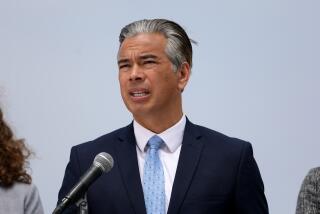Gulf oil spill spawns mega-suit, with likely mega-payouts
Reporting from New Orleans — Spill 4.9 million barrels of oil into the ocean, and this is what you get: the lollapalooza, labyrinthine, mega-mother of all lawsuits.
It encompasses 72 million pages of documents, 20,000 exhibits and 303 depositions — the collective effort of hundreds of lawyers and legal workers.
It involves the Justice Department and about 120,000 plaintiffs: angry fishermen, restaurateurs, state governments and condo owners who say their beach-side property is not worth what it once was. The trial phase, set to begin Feb. 27 in a New Orleans federal courtroom, could go on for nine months.
That is, unless it is averted by the mega-mother of all legal settlements.
It goes by the formal title “In Re: Oil Spill by the Oil Rig Deepwater Horizon in the Gulf of Mexico on April 20, 2010.” And much like the disaster itself, the litigation is startling in its impact and scope, involving billions of dollars of potential fines and damages, arcane matters of maritime law and Space Age details of deep-sea engineering.
There are a host of corporate defendants — chief among them oil giant BP, which was in charge of the drilling project, and Swiss company Transocean Ltd., the owner of the doomed rig — which have been fighting in court over who should shoulder how much of the blame for the disaster that killed 11 rig workers and caused the largest offshore oil spill in U.S. history.
Charles F. Herd Jr., a veteran Houston maritime attorney, calls it an “unheralded” event in the history of American jurisprudence because of its size and complexity.
The biggest question in the days leading up to the trial is whether the Justice Department, which is seeking civil penalties under the Clean Water Act, will reach a settlement with BP or other companies involved in the spill.
The Clean Water Act penalties for BP alone could be as high as $17 billion if it is found to have exhibited “gross negligence” — a failure to take reasonable steps to avert the disaster — during the nonjury trial before U.S. District Court Judge Carl Barbier. Such a decision could increase the fine from $1,100 per barrel to a maximum of $4,300 per barrel, roughly a $13-billion difference. (That figure is based on the 4.1 million barrels of oil left in the gulf after BP cleaned up an estimated 800,000 barrels.)
That potential fine dwarfs the record $70 million in Clean Water Act civil penalties levied last week against MOEX Offshore 2007, a minority investor in the well, which came as part of an overall $90-million settlement with the Justice Department.
“There’s enormous pressure on BP to settle,” said David Uhlmann, director of the environmental law program at the University of Michigan. “No matter how confident BP is about the gross negligence question, that’s just an extraordinary amount of risk for any trial.”
BP Chief Executive Robert Dudley said this month that the company was preparing for the court date, but ready to settle “if we can do so on fair and reasonable terms.”
Experts will also be watching whether the Justice Department will include a non-prosecution agreement with the companies as part of any potential civil settlement, closing a door on future criminal charges.
A Justice spokesman declined to comment Wednesday.
The lawsuits loom despite BP’s agreement to set up a $20-billion fund to compensate spill victims. That fund has paid $6.5 billion to thousands of claimants, most of whom signed a waiver agreeing not to file suit. Two families of the 11 rig workers killed in a fiery explosion are still negotiating wrongful-death cases against BP; the others have settled.
In addition, a separate class-action suit is unfolding in Houston on behalf of thousands of investors accusing BP of securities fraud. That suit alleges that BP made false or misleading statements about its safety programs in the gulf and about its ability to respond to a big spill. A trial date in that case has not been set, according to Richard Mithoff, a co-lead attorney for the plaintiffs.
The disaster that slimed the coastline of four states and closed gulf fisheries for months also triggered hundreds of other individual and class-action cases, which were filed in courthouses around the country.
In August 2010, a federal legal panel lumped those cases together into one suit so that Barbier could address the common questions at the heart of the matter.
A key issue, if the case goes to trial, is the degree to which fault should be allocated among the corporate defendants, which also include Houston-based Halliburton, which performed the cement job on the well, and Cameron International Corp., designer of the failed blowout preventer.
Once the degree of fault is established, the court determines the amount the companies must pay in compensatory damages — that is, the cost of replacing what has been lost. The court will also establish whether the defendants must pay punitive damages, meant to punish and deter bad conduct.
The issue of gross negligence is also significant here because only companies whose actions are deemed grossly negligent must pay punitive damages.
Attorneys for the plaintiffs will argue that BP, the main company in their cross hairs, exhibited gross negligence by not only mismanaging the disaster, but also encouraging a culture that valued profit more than safety — a claim that BP has denied.
Rig owner Transocean is hoping to take a pass on much of this, citing an 1851 federal statute that limits a ship owner’s legal exposure when a vessel goes down. Transocean argues that its exposure should be about $27 million, the current value of the sunken rig.
Despite all the legal complexity, the matter couldn’t be simpler for plaintiffs like Acy Cooper Jr.
Cooper said the spill seriously affected his ability to fish in 2010. More recently, he was forced to close down his family’s Venice, La., seafood restaurant. “If they didn’t do things right,” Cooper said of the defendants, “they need to be held accountable.”
More to Read
Sign up for Essential California
The most important California stories and recommendations in your inbox every morning.
You may occasionally receive promotional content from the Los Angeles Times.










